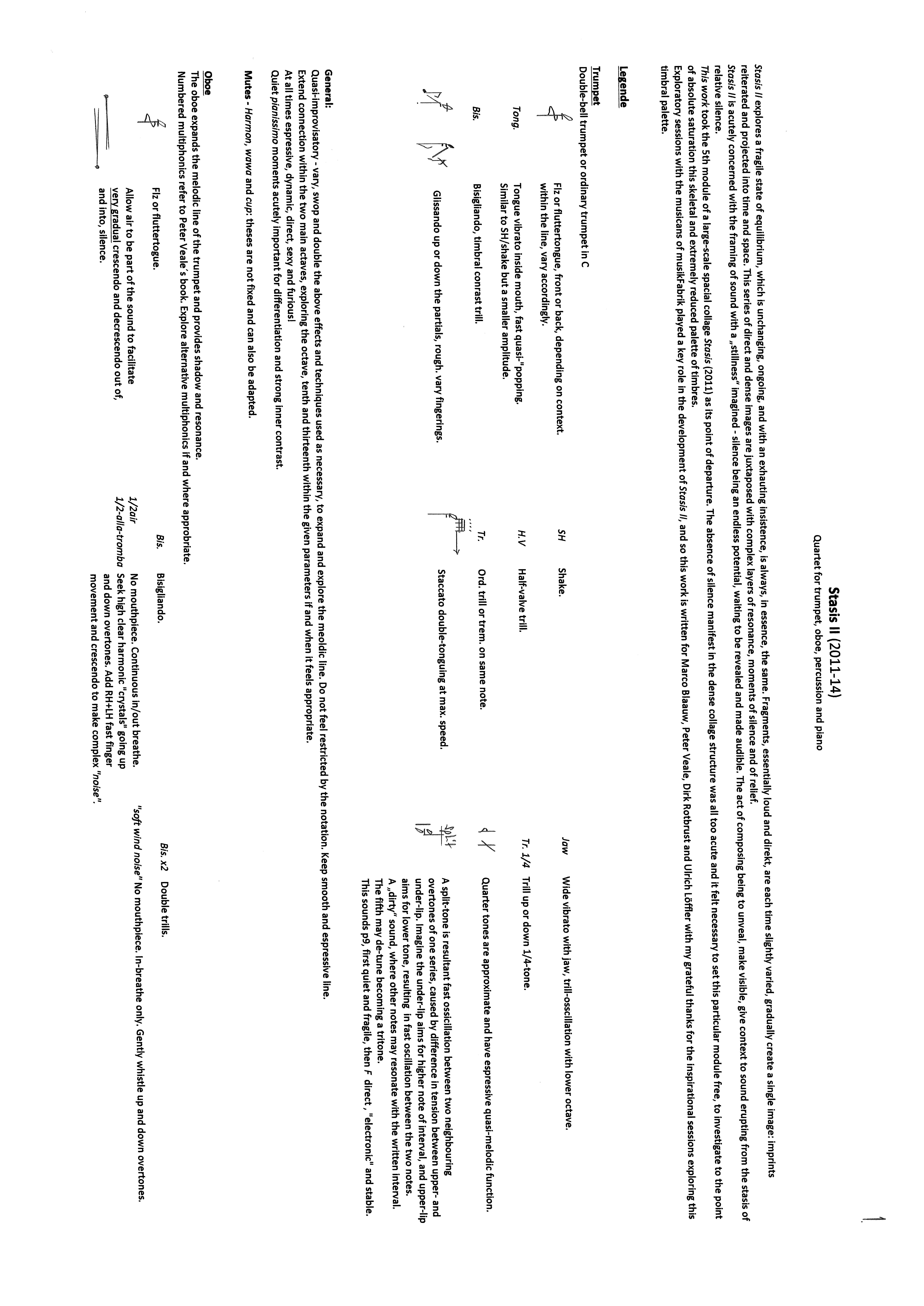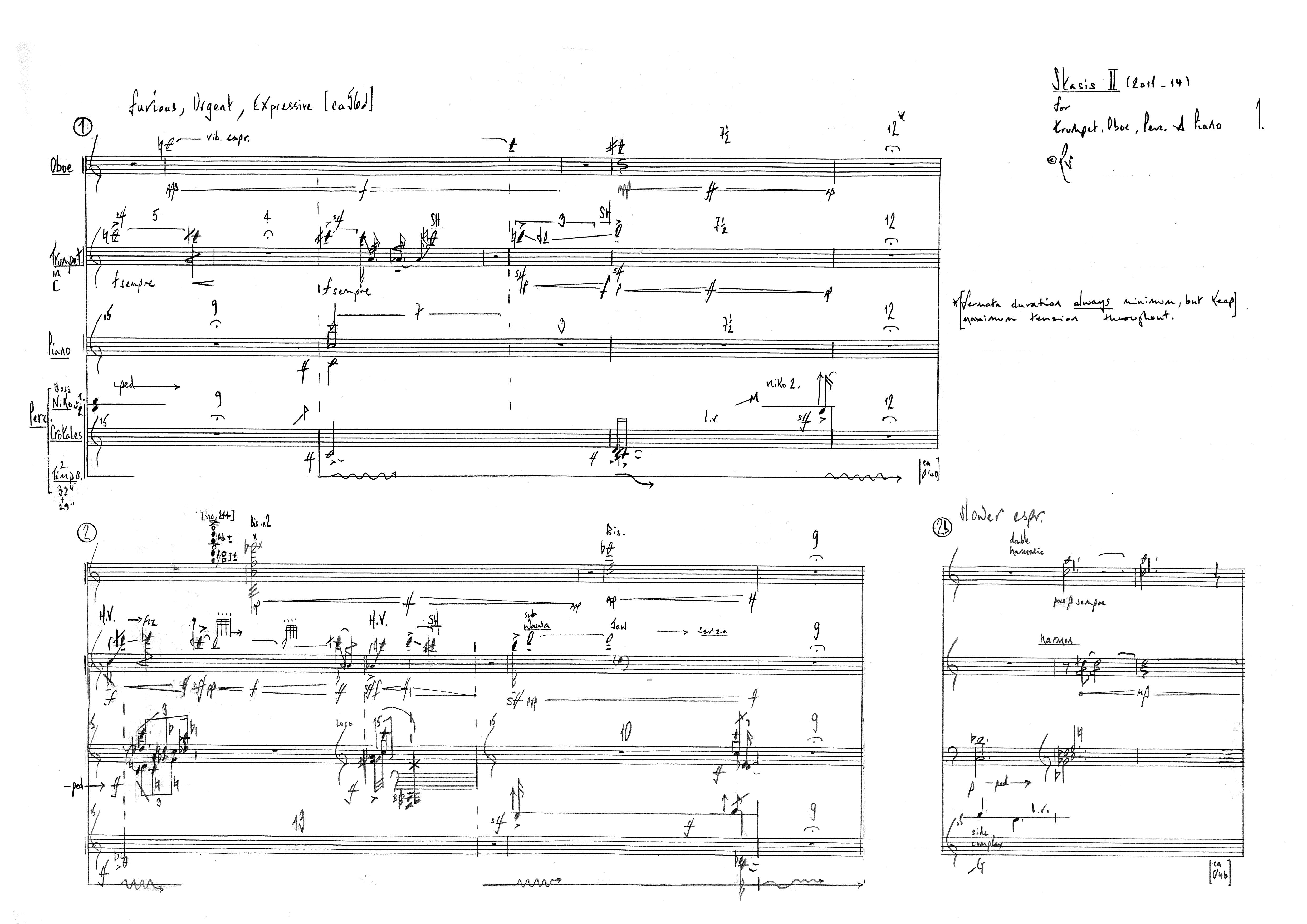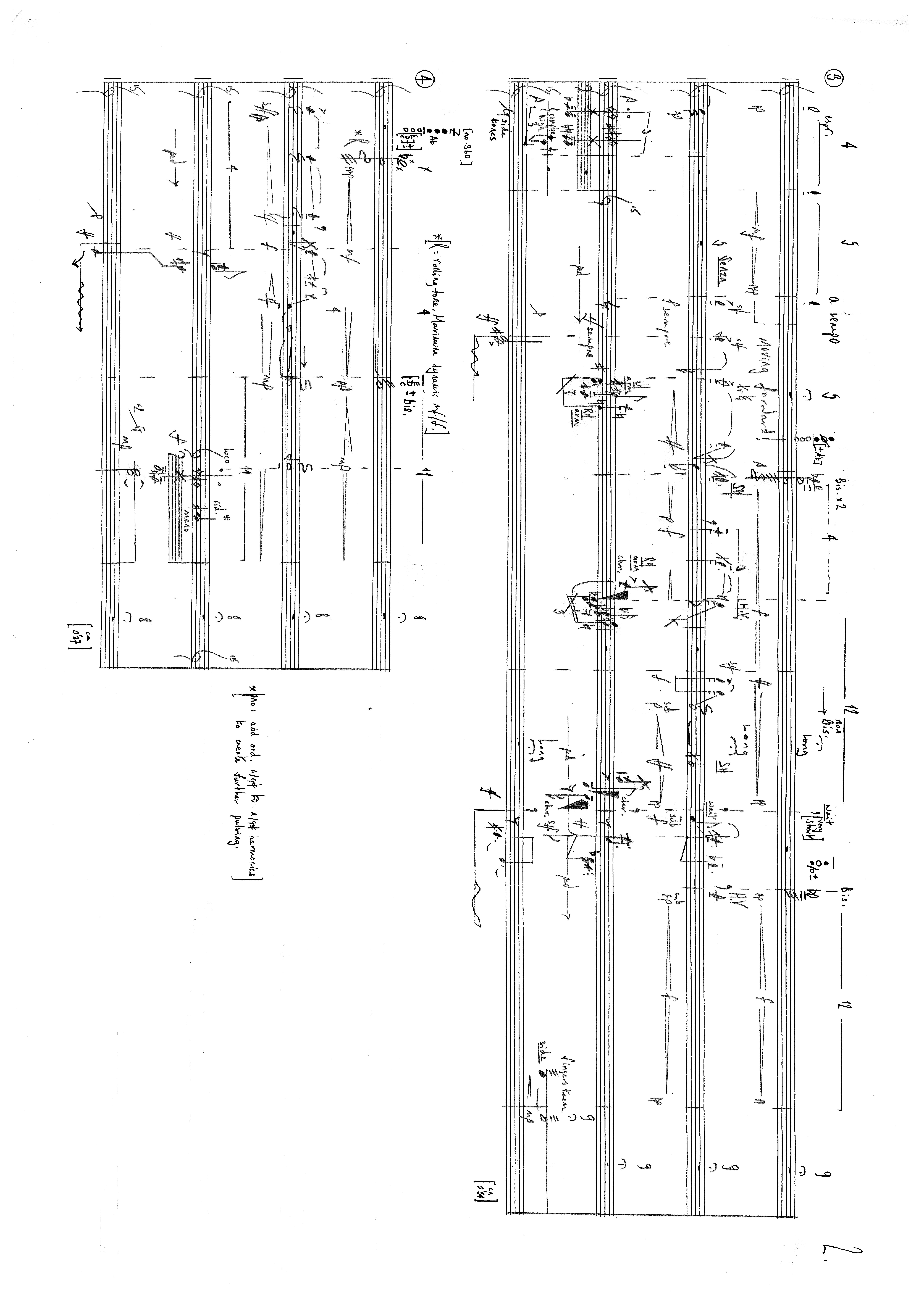SAUNDERS


Stasis II
Quartet for trumpet, oboe, percussion and piano
Performing Score










Stasis II
Quartet for trumpet, oboe, percussion and piano
Performing Score







Quartet for trumpet, oboe, percussion and piano
(2011-14)
Commissioned by Ensemble Musikfabrik and Kunststiftung NRW
for first performance 6th April 2014 at the Klaus-von-Bismarck-Saal, WDR-Funkhaus Cologne
ALLE
RECHTE VORBEHALTEN · ALL RIGHTS RESERVED
LEIP ZI G · L ONDO N · NE W YOR K
Quartet for trumpet, oboe, percussion and piano
Stasis II explores a fragile state of equilibrium, which is unchanging, ongoing, and with an exhauting insistence, is always, In essence, the same. Fragments, essentially loud and direkt, are each time slightly varied, gradually create a single image: imprints reiterated and projected into time and space. This series of direct and dense Images are juxtaposed with complex layers of resonance, moments of silence and of relief.
Stasis II is acutely concerned with the framing of sound with a „stillness" imagined - silence being an endless potential, waiting to be revealed and made audible. The act of composing being to unveal, make visible, give context to sound erupting from the stasis of relative silence.
Thls work took the 5th module of a large-scale spacial collage Stasis (2011) as its point of departure. The absence of sllence manifest in the dense collage structure was all too acute and lt feit necessary to set this particular module free, to investigate to the point of absolute saturation this skeletal and extremely reduced palette of timbres.
Exploratory sessions with the musicans of musikFabrik played a key role in the development of Stasis II, and so this work is written for Marco Blaauw, Peter Veale, Dirk Rotbrust and Ulrich Löffler with my grateful thanks for the inspirational sessions exploring this timbral palette. Legende Trumpet
Double-bell trumpet or ordinary trumpet in C t)
Flz or fluttertongue, front or back, depending on context. within the line, vary accordingly.
Tongue vibrato Inside mouth, fast quasi-"popping. Similar to SH/shake but a smaller amplitude.
Bisigliando, timbral conrast trill.
Glissando up or down the partials, rough. vary flngerings.

Shake.
H.V Half-valve trill.
Tr. Ord. trill or trem. on same note.
Staccato double-tonguing at max. speed.
Jaw Wide vibrato with jaw, trill-osscillation with lower octave.
Tr. 1/4 Trill up or down 1/4-tone.
Quarter tones are approximate and have espressive quasi-melodic function.
A split-tone is resultant fast ossicillation between two neighbouring overtones of one series, caused by difference in tension between upper- and under-lip. lmagine the under-lip aims for higher note of interval, and upper-lip aims for lower tone, resulting in fast oscillation between the two notes.
A „dirty" sound, where other notes may resonate with the written interval.
The fifth may de-tune becoming a tritone.
This sounds p9, first quiet and fragile, then F direct, "electronic" and stable.
Quasi-improvisatory - vary, swop and double the above effects and techniques used as necessary, to expand and explore the meoldic line. Do not feel restricted by the notation. Keep smooth and espressive line.
Extend connection within the two main actaves, exploring the octave, tenth and thirteenth within the given parameters if and when it feels appropriate.
At all times espressive, dynamic, direct, sexy and furiousl
Quiet pianissimo moments acutely important for differentiation and strong inner contrast.
Mutes• Hormon, wawa and cup: theses are not flxed and can also be adapted.
Oboe
The oboe expands the melodic line of the trumpet and provides shadow and resonance. Numbered multiphonics refer to Peter Veale' s book. Explore alternative multiphonics if and where approbriate.
Flz or fluttertogue.
Allow air to be part of the sound to facilltate very gradual crescendo and decrescendo out of, and into, silence.
Bis. Blsigliando.
1/2air No mouthpiece. Continuous in/out breathe. 1/2-alla-tromba Seek high clear harmonic "crystals" going up and down overtones. Add RH+LH fast finger movement and crescendo to make complex "noise".
Bis. x2 Double trills. "soft wind noise" No mouthpiece. ln-breathe only. Gently whistle up and down overtones.
Percussion
2 Timpani - 32 and 29 Inch, tuned down by up to a fourth for greater resonance and for flexibility of pitch and expression with the pedal. Beater for page 9 - medium superball beater for pp/p drag strokes.
2 Bass Nicophones* - 1. small/high (or medium) and 2. large/low Sit on very thin strlps of Moosgummi on two edges across each timpani. Beaters - large thick triangle beaters, medium gong beaters.
* alternative to nicophone: radiator tops, large oven grills, grates, fussabtreter, or other resonant loud metallic objects with slats, which can also be balanced across the edges of the two timpani.
* Available from Domenico Melchiorre <www.melchiorre.ch>.
On top, strike along rills, like very fast gliss.

Single attack. On side, with tonal centre. On side, with complex spectrum.
Single crotales notated down 2 octaves. Crotales are distrlbuted between the two timpani. Placed on the skin to create maximum interference and resonance. Beaters - hard plastic.
Very explorative - Use timpani pedal from very wide quasi-vibrato to tight oscillations, to explore and increase interference tones and resonances. Respond and vary listening to the other three players.
One grand piano with sosentuto/3rd-pedal. Lid open. M usic-stand set back on frame for access to strings for Inside sounds. Mark contact nodes for harmonics with coloured thread on overwound low strlngs Inside piano. Inside or In
Chromatic duster.
Cluster with whole forearm as single attack.
Play tones on the strings Inside the piano:
A fast gllssando on strings wlth hard heavy plectrum in front of dampers. lf frame of piano is in the way, choose a ~ifferent duster as nearby as possible. w:~ tp - ~>\Ht. bJ' fc..sr ol.;.s,.
Durations are given as guidelines and for coordination: these can vary. Adapt to the acoustic, and the performance situation. Also the virtuosic trumpet line defines necessary tempil All players can diverge from written part enhancing the line.
Black-note duster.
Cluster like a glissando, holding down all tones.
Muted. One hand plays the given tone on the keys, the other hand dampens the string for big round dark sound. By the bridge with maximum pressure.
, I White-note duster.
r~IA.\ Open palm tremolando on strings behind dampers.
Muted, sounding harmonic as notated in upper stave. Take alternative low strlng and node ifframe is in the way.
j
Pauses and fermatas are given as minimum durations - these can be extended, but please note fermatas serve to build and maintaln tension. Be very aware of hard-edged contrasts of material both in terms of timbre, pitch and dynamic: Quiet plano espressivo moments acutely important for differentiatlon.
Duration
c.a. 13'00 min.



Rebecca Saunders studied with Wolfgang Rihm at the Musikhochschule in Karlsruhe, Germany, and for a PhD in Composition with Nigel Osborne at Edinburgh University. She lives in Berlin. Saunders’ composition prizes include the 1996 Ernst von Siemens Komponisten-Förderpreis and the 2008 Royal Philharmonic Society Composition Award for Chamber Music. Her works have been performed at festivals including the Huddersfield Festival, the Berlin Biennale and the Darmstadt Ferienkurse. In 2009 she became a member of the Berlin Academy of Arts. Saunders’ works include chroma, for chamber groups distributed throughout the performance space, albescere, written for Ensemble Modern and the Neue Vocalsolisten Stuttgart, and a double concerto for trumpet, percussion and orchestra.
Rebecca Saunders studierte Komposition bei Wolfgang Rihm an der Musikhochschule Karlsruhe und promovierte an der Universität Edinburgh bei Nigel Osborne. Sie lebt in Berlin. Saunders erhielt unter anderem den Komponisten-Förderpreis 1996 der Ernst-von-SiemensMusikstiftung sowie den Royal Philharmonic Society Composition Award 2008 in der Kategorie Kammermusik. Ihre Werke erklangen bei zahlreichen Festivals wie dem Huddersfield Festival, der Berlin-Biennale und den Darmstädter Ferienkursen. 2009 wurde sie zum Mitglied der Berliner Akademie der Künste ernannt. Zu ihren Werken zählen chroma für im Raum verteilte Kammergruppen, albescere (entstanden für das Ensemble Modern und die Neuen Vocalsolisten Stuttgart) sowie ein Doppelkonzert für Trompete, Schlagzeug und Orchester.